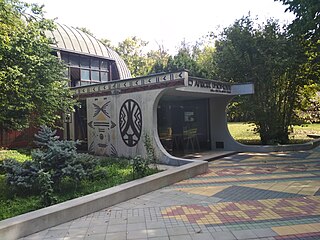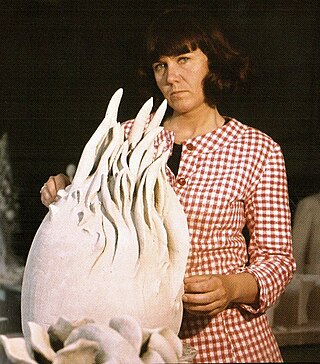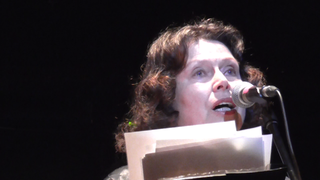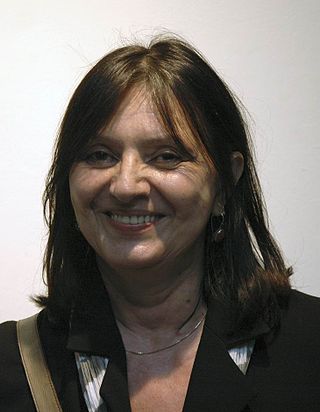Related Research Articles

Petar Lubarda ; 27 July 1907 – 13 February 1974) was a Serbian painter born in Ljubotinj Cetinje.
Matija Vuković was a Serbian sculptor.

The Museum of African Art is a museum located in the urban neighborhood of Senjak, Belgrade, the capital city of Serbia.
Milovan DeStil Marković is Serbian visual artist, who began his career in the early 1980s. Active for over two decades, he is recently described as father of transfigurative painting and the text portrait. Visiting Professor Art in Context at the University of Arts, Berlin.
Vessna Perunovich is a Yugosla-born, Canadian / Serbian visual artist based in Toronto, Ontario and Belgrade, Serbia. She was born in 1960 in Zaječar, Serbia, FPR Yugoslavia. Her father was originally from Montenegro and her mother was from Serbia, born in North Macedonia. She immigrated with her family husband and daughter to Toronto in 1988. She earned her B.F.A in 1984 at the Academy of Fine Arts at the University of Belgrade, Yugoslavia. She earned her M.F.A. also from the Academy of Fine Arts at the University of Belgrade in 1987. In 2004, she was invited to the University of Guelph in Ontario to guest lecture. In 2004 she was invited to participate at the thematic Artist Residency Informal Architectures Symposium in Banff, Alberta to create work and to do an artist presentation. She was a sessional teacher at the Ontario College of Art and Design in Toronto from 2005 until 2011. Her most recent artist presentation was at the Museum of Contemporary Art Belgrade coinciding with her solo survey exhibition at the Gallery-Legacy Milica Zorić and Rodoljub Čolaković in 2023. Other artist presentation include Ontario College of Art and Design in Toronto and the other one in Havana, Cuba for the "International Artists' Presentation".

Simonida Rajčević is a Serbian painter and artist. She has had more than 20 individual and 50 group exhibitions.
Dragan Tanasijević is a Serbian photographer.
Tatjana Ilic – Tanja Ilic is a fine artist. She graduated from the Faculty of Fine Arts – Majoring in graphics in Belgrade in 1995. During her studies she enrolled at the Düsseldorf Arts Academy in the class of Jannis Kounellis, section Bildhauerei. On the recommendation of her professor, she acquired a Master's status in 1997, and continued to work in the same class until 2000. She has been a member of the Association of Fine Artists of Serbia since 1995. She has also been a member of the International Artists Forum since 2003. In the same year her artwork "Vogel" was incorporated into the analytical review "Performance – Art – Kontext".

Mirjana Isaković is a Serbian sculptor and ceramist.
Dragan Malešević Tapi was a Serbian painter. Although by vocation an economist, he is generally considered one of the leading painters of Serbian hyperrealism style.

Katalin Ladik is a Hungarian poet, performance artist and actress. She was born in Újvidék, Kingdom of Hungary, and in the last 20 years she has lived and worked alternately in Novi Sad, in Budapest, Hungary and on the island of Hvar, Croatia. Parallel to her written poems she also creates sound poems and visual poems, performance art, writes and performs experimental music and audio plays. She is also a performer and an experimental artist. She explores language through visual and vocal expressions, as well as movement and gestures. Her work includes collages, photography, records, performances and happenings in both urban and natural environments.

Slobodanka Stupar, is Serbian visual artist who lives and works in Belgrade, Athens and Cologne.

Ivanka "Ida" Ćirić was a notable Serbian illustrator for children.
The Applied Artists and Designers Association of Serbia is an organization that supports Serbian professionals working in the fields of art and design. This includes architecture, textiles, scenography, costume design, sculpture, graphics, paintings, ceramics, art photography, restoration, and art history.

Natalija Cvetković was a Serbian war artist.
Petar Palaviccini or Palavicini was a Croatian sculptor of Italian ancestry.
Lazar Trifunović was a Serbian art historian, art critic and professor at the University of Belgrade.

Mirjana Lehner Dragić is a Serbian painter.

The "Josip Broz Tito" Art Gallery of the Nonaligned Countries was an art gallery in Titograd in the Socialist Republic of Montenegro, one of the federal subjects of the Socialist Federal Republic Yugoslavia. It was the only art institution established directly by the Non-Aligned Movement's decision.
References
- 1 2 3 Catalogue for One Woman Show, ‘Bojana Komadina’ text by Milanka Todić published by the Museum of Applied Art, Belgrade, Yugoslavia
- ↑ "Completed PHD | AA PHD".
- ↑ "Bojana Barltrop: The Great Chain of Being, Čolaković Legacy".
- 1 2 "Sequences. Art of Yugoslavia and Serbia from the collection of the Museum of Contemporary Art".
- ↑ 1979 ‘About Bojana Komadina’ text by Gordana Marić in ‘Playboyana’ published instead of the catalogue for one woman show ‘Woman who can it all’ by Happy Gallery, Student’s Cultural Centre, Belgrade, Yugoslavia
- ↑ 1992, Catalogue for the solo exhibition, ‘Bojana Komadina’ text by Milanka Todić published by the Museum of Applied Art, Belgrade, Yugoslavia
- ↑ "Legat Colakovic Samostalna Izlozba Bojane Barltrop Great Chain Being". www.designed.rs.
- ↑ "Arte - Aktuelno :: Bojana Barltrop: The Great Chain of Being". www.arte.rs. Retrieved 7 April 2024.
- ↑ "Veliki Lanac Postojanja". www.seecult.org.
- ↑ "Veliki lanac postojanja u fotografijima Bojane Baltrop - Kultura - Dnevni list Danas" (in Serbian). 24 May 2017. Retrieved 17 March 2024.
- ↑ "The Great Chain of Being". www.radiolaguna.rs.
- ↑ "Bojana Barltrop: The Great Chain of Being – BLJ@k". Archived from the original on 3 January 2018. Retrieved 2 January 2018.
- ↑ LookerWeekly (20 May 2012). "LookerWeekly.com magazin - Magazin za mlade i radoznale". lookerweekly.com. Retrieved 17 March 2024.
- ↑ "Izložba Bojane Barltrop u Galeriji-legatu Milice Zorić i Rodoljuba Čolakovića". Blic (in Serbian). 26 May 2017. Retrieved 7 April 2024.
- ↑ 1982, Catalogue for the exhibition Arteder ’82 Muestra Internacional de Obra Gráfica/ International Graphic Arts Exhibition, Bilbao, Spain
- ↑ 1981,‘Boyana Komadina’ text by Slavko Timotijević in the catalogue for the exhibition ‘Some aspects of Yugoslav Contemporary Photography’ published in collaboration Happy Gallery, Student’s Cultural Centre, Belgrade, Yugoslavia and Open Eye Gallery, Liverpool, UK
- ↑ 1983, Catalogue for the exhibition ‘Einige Aspekte der zeitgenössischen jugoslawischen Fotografie’ (‘Some aspects of Yugoslav Contemporary Photography’) published by Fotogalerie Forum Stadtpark, Graz, Austria
- ↑ Catalogue for the exhibition ‘Examples of Instant Art Video-Polaroid’ text by Slavko Timotijević, Art Gallery, Cultural Center Belgrade, Yugosla
- ↑ 1991, Catalogue for the exhibition ‘150 years of Serbian photography’ text by Slavko Timotijević, published by the Serbian Academy of Art and Sciences, Belgrade, Yugoslavia